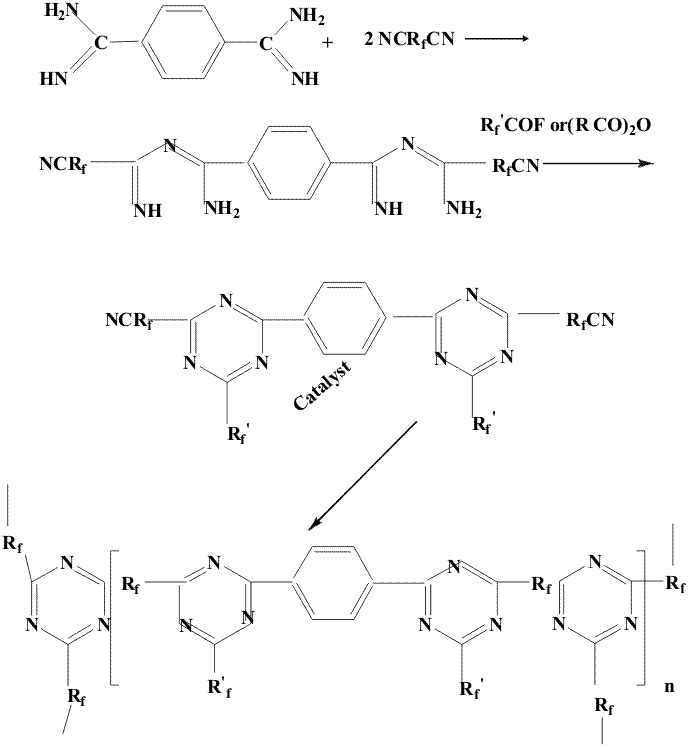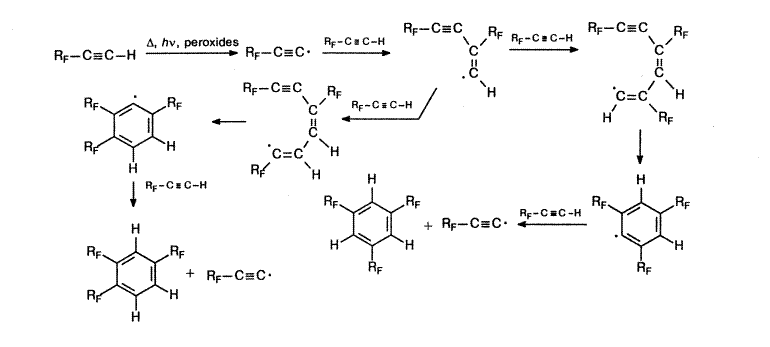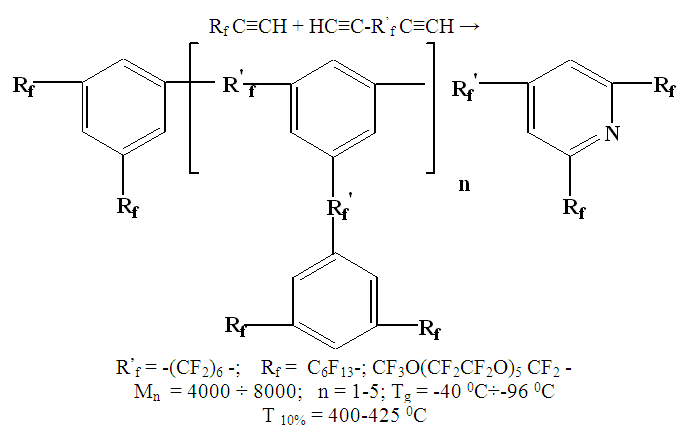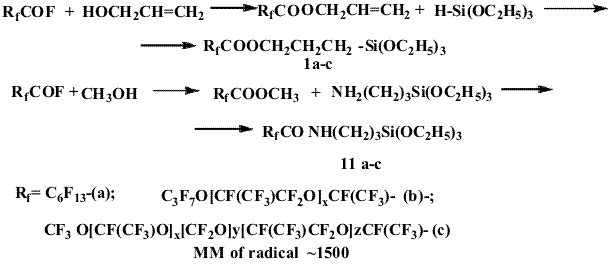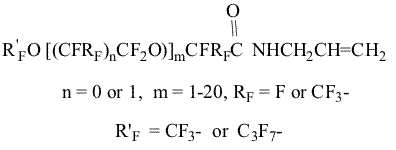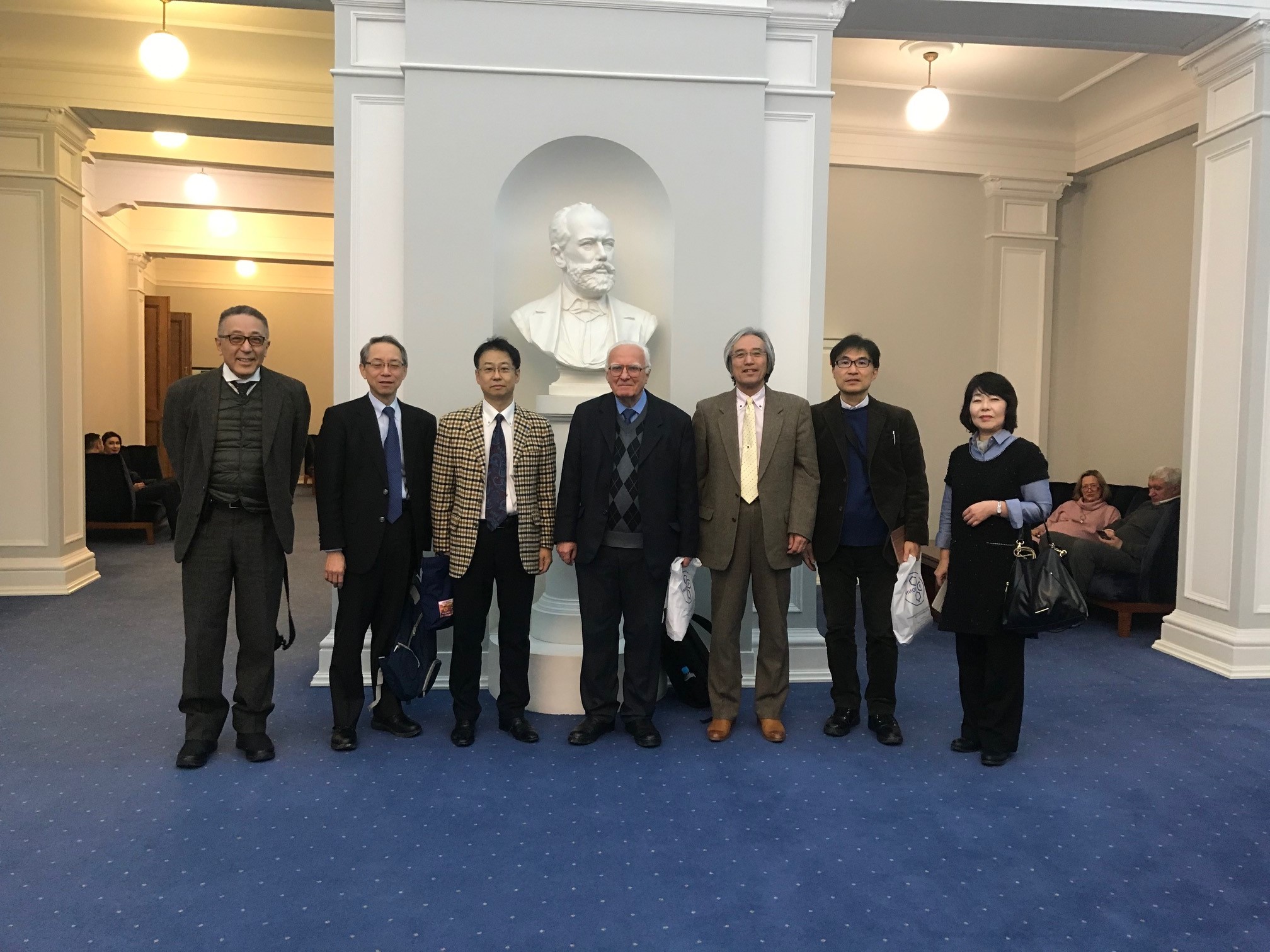Fluorine Notes, 2010, 69, 3-4
SYNTHESIS AND PROPERTIES OF HETERO-CHAINED FLUORINE-CONTAINING OLIGOMERS AND POLYMERSS.P. Krukovsky, A.A. Yarosh, D.V. Batizat, A.A. Glazkov, M.Yu. Popovich, O.U. Smirnova, A.M. Sakharov N.D. Zelinsky Institute of Organic Chemistry RAS (ZIOC) ,Laboratory of Polymer Chemistry. Abstract. Oligomeric perfluoroalkylenoxides with nitril (CN), trifluorovinyloxy (CF2=CFO-), ethynyl (CH=C-)and other reactive groups were synthesized. Linear and cross-linked fluorocontaining triazine polymers with Tg -30 - -140 were obtained from oligomeric nitriles. It is shown that the partial substitution of perfluoroalkyl substituents on the aromatic increases the stability of triazine cycles to the influence of the nucleophilic reagents. Keywords: triazine, fluorine-containing oligomers, copolymers, lubricants Research on the synthesis of fluorine-containing hetero-chained oligomers and polymers of various structures and intended for numerous applications were started in 1965 in ZIOC RAS at their Polymer Laboratory led by V.A.Ponomarenko USSR AS correspondent member. By that moment carbochain fluoropolymers (fluorinated plastics and rubbers) were already in general use. Neither carbochain fluoropolymers nor fluorinated olefins are suitable for the manufacture of materials operative both at very low (below minus 130 oC) and high temperatures (300-350oC). Hetero-chained fluorinated polymers, particularly, polyperfluoroalkylene oxides are much more promising in those fields of application. Thus, thermal stability of polytetrafluoroethylene oxide (PTFEO) exceeds that of polytetrafluoroethylene (for PTFEO its temperature of maximal thermodestruction rate is 628oC, and activation energy of thermodestruction is 98 kcal/mole while for PTFE those are 568oCand 85 kcal/mole correspondingly) [1]. Some polyperfluoroalkylene oxides are known for their excellent frost resistance. As it was shown by Ponomarenko et al.[2] thermodynamic and kinetic flexibility ("superflexibility") of PTFEO and polydifluorometylene oxide chains are very high resulting in very low vitrification temperatures for polymers that involve such fragments. We found an empiric linear dependence of vitrification temperatures (Tg) of perfluorinated polyethers on the ratio of oxygens number to fluorines number (α=O/F) within an elemental polymer unit [3]: Tg =10-370α (o For polymers with -[CF(CF3)CF2O]n-, -(CF2CF2O)n- and -(CF2O)n-, experimental values of their vitrification temperatures detected by the thermomechanical method are in very good agreement with those calculated. The same dependence is also valid for polymers that belong to other classes but still contain perfluoroalkylene oxide fragments both in their main and side chains. Therefore, polyperfluoroalkylene oxides are best suited to the manufacture of materials with wide temperature range of workability, but currently those polymers, produced either through ionic polymerization or through the interaction between perfluorinated olefins and oxygen, are known to have relatively low molecular weights. Therefore, it seems that the most reasonable approach to manufacturing of high-molecule polymers with perfluoroalkylene oxide units in chains would involve the synthesis of oligomers with reactive groups and their further conversion to linear or cross-linked polymers. Of course, the chemical nature of those reactive groups has significant influence on the finish product properties. Oligomeric perfluoroalkylene oxides with nitrile (CN), trifluorovinyloxy (CF2=CFO-), ethynyl (CH
followed by their conversion to corresponding nitriles, perfluorovinyl ethers, alcohols and other derivatives by usual methods. X- RF - X, here X = -COF; -CN; -OCF=CF2 Oligomeric perfluoroalkylene oxides with tetrafluoroethylene- and difluoromethylene oxide units in the chain CF3O(CF2CF2O)a(CF2O)b-CF2-X X-(CF2CF2O)a(CF2O)bCF2-X X= -COF; -COOCH3; -CN etc. a/b = 0.1 - 0.2 were prepared from the tetrafluoroethylene photooxidation products that involved peroxide bonds. The reduction of those bonds was conducted either by hydrogen in the presence of palladium on activated carbon, or by hydroiodic acid in methanol medium. Staring with oligomeric nitriles liner and cross-linked fluorine-containing triazine polymers were prepared with Tg ranging from -30 to -140 oC [3].
Linear oligomeric perfluorinated octaalkylenetriazines were recommended for usage as oil/lubricant substrates or efficient inhibitors in perfluoropolyether thermodestruction in the presence of metals or metal oxides. The oligomer synthesis was rather complicated and multistep. Cyclotrimerization of mono/dinitrile blend at pressure 300 -1400 MPa in the presence of catalysts amidines of perfluorinated carboxylic acids resulted in branched oligomeric perfluoro oxaalkylenetriazines with molecular weight 3000 - 10000 and vitrification temperature ranging from -80 to -120 oC. It was a rapid one-step process (with rate 10 times exceeding that at normal pressure) [4].
These oligomers also proved to be efficient inhibitors in the thermodestruction of perfluorinated ethers [5].
Fig.1 Mass loss ( 1 and 2 - perfluorinated polyethers without stabilizers (oligoperfluoropolytriazines) Notwithstanding their benefits polyperfluorinated oxaalkylenetriazines have one disadvantage: they are labile to the action of nucleophilic reagents, particularly ammonium. We demonstrated that the resistance of triazine cycles to those reagents grows considerably if perfluoroalkyl substituents are partially replaced by those aromatic. A number of 1,4-bis-(4,6-perfluoroalkyltriazinyl)-benzenes were synthesized with properties and area of application dictated by the nature of those perfluoroalkyl substituents [6, 17].
In the case of relatively long perfluoroalkyleneoxide radicals liquid oligomers were obtained. In Table 1 some properties of an oligomer named "Ftolan" are presented and compared to those of perfluorinated polyether PEF-240 [7]. Table 1. Properties of "Ftolan" oligomer
In the case of relatively short
Glass-reinforced plastics based on those bonding additives are virtually non-combustible materials (table 2) and suitable radio-frequency dielectrics in radio electronic applications [3]. Table 2. Some properties of glass-reinforced plastics
Novel fluorinated oligomers applicable as substrate for consistent greases or cross-linked polymers known for high thermostability and chemical inertness, were produced through the polycyclotrimerization of perfluorinated alkylacetylenes. Mechanisms of the formation of perfluoroalkylacetylenes [8], oligomers and polymers on the basis of those oligomers are shown below.
RF = C6F13 -; CF3O(CF2CF2O)nCF2-; CH=C-(CF2)6- When studying the cyclotrimerization of perfluoroalkylacetylenes we established that independent of the chosen initiation method (thermal, radiation chemical or peroxide) the ratio of 1,3,5-tris-perfluoroalkylbenzenes to 1,2,4-tris-perfluoroalkylbenzenes was 7:1 and stayed unchanged. This result allowed to assume the reaction mechanism as follows [9]:
Joint cyclotrimerization of fluorine-containing monoacetylenes and diacetylenes resulted in branched oligomers cross-linked polymers distinguished for both high thermostability and resistance to the action of concentrated acids and bases [10].
The synthesis of oligomeric nitriles and acetylenes with perfluoroalkylene oxide bonds in their chains is rather complicated and involves a number of steps. Therefore a method was developed for the immediate production of branched oligomers and cross-linked fluoroelastomers starting with perfluoroalkyleneoxides containing peroxide groups in their chains. CF3O(CF2CF2Î)a (CF2Î)b-A-( CF2CF2Î)a (CF2Î)b- CF2 COF A - peroxide units: OCF2OOCF2O-; OCF2CF2OOCF2CF2O-; OCF2OOCF2CF2O- Those perfluorinated polyperoxides were prepared through the oxidation of tetrafluoroethylene. Copolymerization of those perfluorinated polyperoxides with perfluorinated divinyl ethers under UV-irradiation or at heating resulted in the formation of cross-linked polymers, the latter after thermal processing in vacuum at 250-280 oC had Tg up to -145oC and their temperature of 5% mass loss was +370oC [11]. Cross-linked polymers were also produced by the thermal Copolymerization of perfluoropolyperoxides (1) with perfluoro-1,3-butadiene at 180-220 oC.
These elastomers involved 85% of gel fraction and swelled very well in fluorinated solvents. When swollen they are stabilizable with elemental fluorine, just as in the process of liquid inert perfluorinated polyethers manufacture. The synthesis and molding of cross-linked perfluoroalkyleneoxides should be conducted simultaneously, and therefore require special methods for treatment [6]. Recently the interaction of perfluoroalkyleneoxides involving peroxide groups (1) with perfluoro- and polyfluorinated aromatic substances (II) was studied.
The destruction of initial perfluorinated alkyleneoxides (1) was conducted thermally and their interaction with fluoroaromatic substances (II) resulted in the formation of structured perfluorinated polyethers with high content of gel fraction in them [12]. Thus prepared cross-linked polymers had vitrification temperature -140oC and their temperature of 5% mass loss was 375oC. The proposed materials may be recommended for the components of lubrication or sealing compositions operated in aggressive media, or in the production of general mechanical rubber goods. Considerable recent attention has been focused on the protection of historical monuments and monumental pieces of arts against harmful environmental effects. We developed the methods for the synthesis of a number of derivatives of oligomeric perfluorinated carboxylic acids with reactive trialcoxylyl groups [13-15].
Those substances are easily soluble in organic or organofluoric solvents. Their application to limestone, sandstone, marble or other materials provides those surfaces with water-repellent, oil-repellent and antisoiling properties. The novel organofluoric-silicon substances are more efficient than hydrophobisators based on some organic-silicon substances, and unlike those hydrophobisators possess high oleophoby as well. Limiting wetting angles of limestone treated with such preparation were 130-140oC and 90-95oC for water and decahydronaphthalene, respectively. A number of monuments in Moscow have already been treated with those preparations. Even 10 years after coating the monuments with organofluoric-silicon composition "Ftorsam-39" neither algae nor fungi growth was observed on them. In recent time we produced water-emulsion compositions based on the mentioned organofluoric-silicon "Ftorsam-39" with protection properties similar to those of hydrophobic and oleophobic preparations that make use of organic solvents [16]. To improve the freeze resistance of rubbers based on fluoroelastomers SKF-26 and SKF-32 we applied perfluoroalkyleneoxide oligomers with reactive allylamide groups.
Those substances were introduced into the rubber composition at the stage of vulcanization. In the case of SKF-32-based rubber adding of those substances in amount of 15 per 100 parts by mass of caoutchouc decreased the vulcanizate brittle point from -20oC to -48oC?, while its coefficient of elastic restitution at -20oC increased from 0 to 0.48 [17, 19]. *** The studies on synthesis and characterization of novel fluorine-containing oligomers, polymers and products based on them we conducted in tight contacts with researchers from many research institutions: FSUE RSC "Applied Chemistry" (Perm branch) - M.I. Lyapunov, K.N. Bildinov, G.I.Lekontceva. Usually those joint works resulted in Certificates of Authorship of the USSR or RF Patents. Some of them are already introduced in practice: Unique labricants for cosmic system «Energy- Buran», Novel binding additives to non-flammable reinforced plastics operative in high-voltage and high-frequency electromagnetic fields, Organofluoric surfactants for ferromagnetic liquids based on perfluorinated polyethers, water emulsions of organofluoric-silicon substances and compositions for extinguishing of polar organic liquids. References 1. A.Donato, M.Lenzi, A.Mele. J. Macromol. Sci. Chem., (1965) A1 p.3429 |
2. S.G. Mashinskaya, V.M. Men’ shov, L.A. Kiseleva, V.A. Ponomarenko . Polymer preprints (1995) 36 № 2 392. Paper presented at the Chicago, Illinois Meeteng of the American Chem. Society.
3. S.P. Krukovsky, A.A. Yarosh, A.A. Glazkov, D.V. Batizat, T.N. Redina. J. Fluorine Chemistry, 96 (1999), p. 31-33.
4. V.A. Ponomarenko , T.N. Redina, A.A. Yarosh, A.A. Zharov, V.M. Zhulin, A.V. Ignatenko. // Izv. Akad. Nauk ser. khim.1997.,s.1893-1896.
5. T.N. Redina, A.A. Zharov, A.A. Yarosh, V.A. Ponomarenko.// Izv. Akad. Nauk, ser. khim., № 9, s. 1814-1816, 1995
6. S.P. Krukovsky, A.A. Yarosh, A.A Glazkov. // Intern. Symp. “Advanced Technologies & Production of organic and inorganic chemistry - 95. Moscow, April 25-28, 1995. Section B. Reports p.102-106.
7. V.A. Ponomarenko, M.B. Bakalejnikov, N.V. Kuznetsova, A.A. Yarosh. Novye termostojkie zhidkosti. //Sb. Plastichnye smazki, M., 1982, TsNIITEneftekhim, s.3
8. D.V. Batizat, A.V. Ignatenko, A.A. Yarosh, V.A. Ponomarenko. // Izv. Akad. Nauk SSSR, ser. khim. s.1163-1165, 1988.
9. D.V. Batizat, A.A. Glazkov, A.V. Ignatenko, A.A. Yarosh, V.A. Ponomarenko. // Izv. Akad. Nauk, ser. khim.. № 10, 1994.
10. D.V. Batizat, A.A. Yarosh, A.A. Glazkov, V.A. Ponomarenko . //Zhurnal organicheskoj khimii, 1994, 30, № 8, s. 1230-1233.
11. A.A. Glazkov, A.I. Ignatenko, S.P. Krukovskij, V.A. Ponomarenko. //Zhurnal organicheskoj khimii, 1994, t.30, № 8, s. 1193-1196.
12. A.A Glazkov, A.V. Ignatenko, A.M. Saharov. // Tezisy dokladov pervoj Vserossijskoj nauchno-prakticheskoj konferentsiya. Ftorpolimernye materialy: Nauchno-tekhnicheskie, proizvodstvennye, kommercheskie aspekty. Kirovo-Chepetsk, 2008g, UD17, s.32
13. S.P. Krukovskij, A.A. Yarosh, V.M. Kotov, T.A. Pryahina, V.N. Yarosh, B.G. Zavin i dr. Patent RU 2149151, Publ. 20.05.2000. Bull. №14.
14. S.P. Krukovskij, A.A. Yarosh, V.M. Kotov, T.A. Pryahina, V.N. Yarosh, B.G. Zavin i dr. Patent RU 2151151, Publ. 20.06.2000. Bull. № 14.
15. A.A. Yarosh, S.P. Krukovsky, T.A. Pryakhina, V.M. Kotov, B.G. Zavin, A.M. Sakcharov. //Mendeleev Commun. 2006, p.190-192
16. A.M. Saharov, A.A. Yarosh, S.P. Krukovskij, O.U. Smirnova, V.N. Yarosh, V.M. Kotov, B.G. Zavin. // RU Patent RU 2327674 C1, Publ. 27.06.2008, Bull. № 18
17. Z.N. Nudel'man, S.P. Krukovskij, L.N. Lavrova, YU.L. Morozov, A.A. YArosh, E.E. SHeveleva. //RU Patent RU 2203886 C1, Publ. 10.05.2003. Bull. № 13
18. A.A. Yarosh, S.P. Krukovskij, A.M. Saharov, D.V. Batizat, M.Yu. Popovich, T.N. Redina. //Tezisy dokladov pervoj Vserossijskoj nauchno-prakticheskoj konferentsiya. Ftorpolimernye materialy: Nauchno-tekhnicheskie, proizvodstvennye, kommercheskie aspekty. Kirovo-Chepetsk, 2008g, UD20, s.35.
19. S.P. Krukovsky. A.A. Yarosh, A.M. Sakharov.// 7-th Regular German-Russian Ukrainian Symposium on Fluorine Chemistry. Sept. 29-Okt. 2, 2008 in Smitten, DFR.
Fluorine Notes, 2010, 69, 3-4
 C-) and other reactive groups were synthesized. Ionic polymerization of hexafluoropropylene oxide was used to prepare difunctional oligomers with fluoroanhydride end-groups,
C-) and other reactive groups were synthesized. Ionic polymerization of hexafluoropropylene oxide was used to prepare difunctional oligomers with fluoroanhydride end-groups,
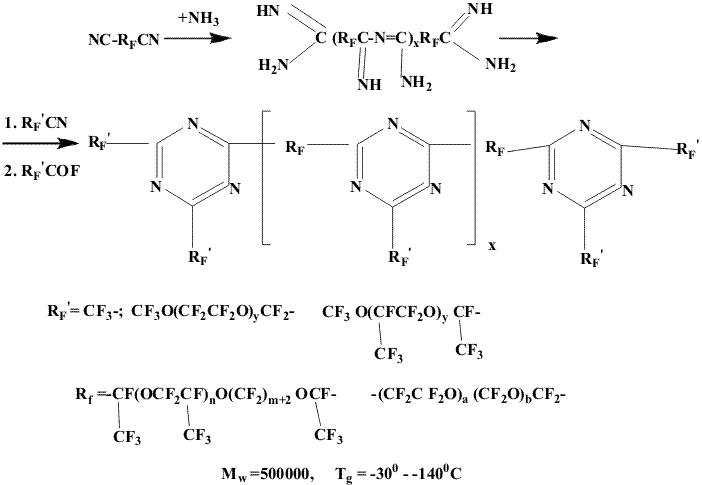
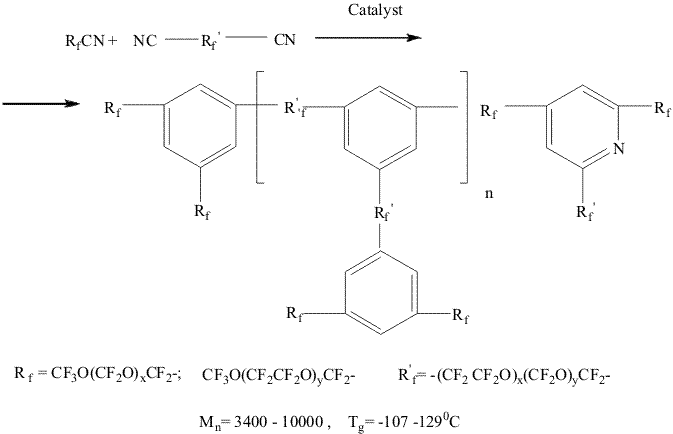
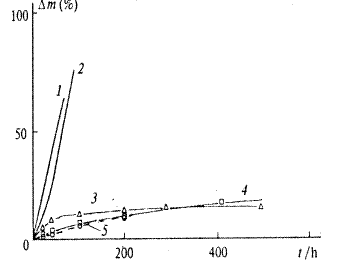
 m) of perfluorinated polyethers CF3O(CF2CF2O)x(CF2O)yCF3 in the presence of Steel-45 at 200 oC
m) of perfluorinated polyethers CF3O(CF2CF2O)x(CF2O)yCF3 in the presence of Steel-45 at 200 oC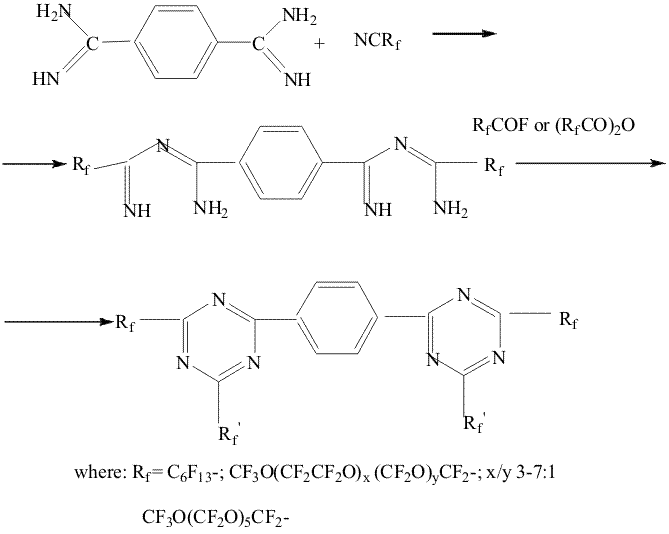
 -cianoperfluoroalkyl substituents novel thermoreactive bonding additives were prepared intended for reinforced plastics.
-cianoperfluoroalkyl substituents novel thermoreactive bonding additives were prepared intended for reinforced plastics.